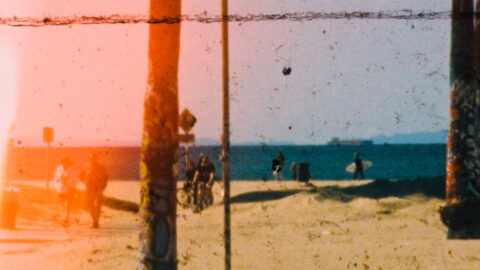Mark Jenkin is one of the last great British eccentrics. Shooting exclusively on film, which he hand processes himself, his movies live and breathe pure cinema; at once unique to the British Isles while exhibiting a lovely, abiding Celtic charm.
His latest, I Saw the Face of God in The Jet Wash (2025), is at once a rambling, frantic, overloaded diary, a haphazard collection of ideas, impressions, feelings and sentiments, and a wonderful supersonic tour across the misunderstood nether-regions of the British Isles densely filled with about a million movie references. I absolutely adored it.
How can you not love a movie that starts with “Chapter 11: The Abandoned Sea Pools of Man?” Jenkin starts with a reflection on his journey from Liverpool to Douglas, on the Isle of Man, with gorgeous Super8 footage of the Liverpool dock that evokes both the ending of News From Home (Chantal Akerman, 1975) and the stone-cold Scouse masterpiece Letter to Brezhnev (Chris Bernard, 1985), where a local girl falls in love with a Russian sailor, thus defying the popular status quo of the Cold War.
(That last detail about Letter to Brezhnev was not necessary or pertinent to what actually happens in Jet Wash, but a part of me wants to get into the spirit of what Jenkin is attempting here, starting one tangent of superfast voiceover before moving onto the next topic so fast, you can’t even keep up. This is a pure diary, building concepts on top of each other in a bold, endlessly fascinating way. Or like being cornered by a man in the pub, talking and talking and talking, without letting you get a word in edgeways.1Czechia does seem like a strange place to debut the film, but the more I think about the rambling nature of 20th Century Czech literature — Karel Čapek and Jaroslav Hašek, especially! — the more this makes a weird, perfect kind of sense.
There are shades of the film diaries of Jonas Mekas here, as well as the structuralist, loopy British madness of Peter Greenaway’s The Falls [Peter Greenaway, 1980]. But while certain influences are certainly there, the way that he tours and photographs Celtic landscapes — the regions that have resisted Anglo-homogenisation and the awful sameness that permeates British, particularly English life, to varying success — feels unique to Jenkin and his proud Cornish spirit.)
Anyway, when he finally gets to the Isle of Man2A place that occupies an outsize level of fascination in my own imagination, especially since I found out that one should always say “Hello” to the fairies when you cross the aptly-named Fairy Bridge. Or how can a place not fascinate you when, during the COVID lockdown, a legend broke the rules and travelled there from Scotland on a jet ski just to see his girlfriend?, he believes that he has been there before. But actually, he hasn’t. He just saw it in a movie. The resultant film is a lightning-quick 17-minute tour of Cornish locations and their cinematic counterparts, a diary of personal experience that reaches towards something rather moving and profound.
It has certainly made me think more about my own identity. Reflecting on a screening in Normandy, he talks about being in the same location where Tale of Summer (1996), my favourite Éric Rohmer film, was made. And he has made me realise just why it’s my favourite Éric Rohmer film. It’s not merely the brilliant structure, beautiful women or timeless, effortless cinematic quality. It’s the way that Rohmer is so deeply attuned to the Celtic feel of the region, culminating in Gwenaëlle Simon’s pure kino rendition of the sea shanty “The Corsaire’s Daughter.”
I hadn’t previously caught on that, as a half-Celt myself, this was always going to be the most relatable Rohmer film — deep down in my bones, where the ancestors linger on, telling me not to go into the sea, to put a coat on, in case it rains. As Jenkins himself says, when he sees the boats in the French dock, “And the fishing fleet looked just like home.” Through these ideas and juxtapositions and connections, the Cornish filmmaker sneaks in an emotional manifesto for a united Celtic spirit; divided by colonialism, but forever connected through common heritage.
But what would that look like? A zoom in on a flag in the Isle of Wight (or was it the Isle of Man? The film moves so fast it’s hard to remember), shows a difficult hodgepodge of all the different flags. Essentially, Jet Wash in a nutshell. Or at least it would be, until Jenkin flies off to Los Angeles, trading the Atlantic for the Pacific, overcast clouds and rain for pure clear sunshine and a surfer cool mentality. But once he makes it to Venice Beach — probably the most cinematic beach in the world3I go further on this in my review of Breathless (Jim McBride, 1983) for my intermittent Hollywood Niche column — it all becomes clear. It’s another place he’s seen before. And now he’s here. But soon, he’ll be somewhere else. Hopefully making more films.
Redmond is the editor-in-chief of Journey Into Cinema.
